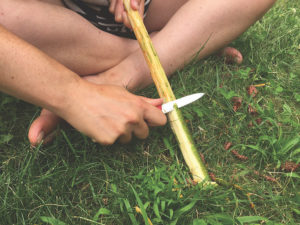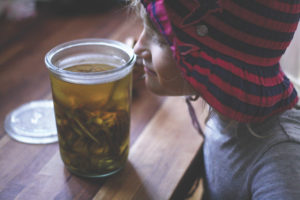
Earlier this summer, I discovered a wild cherry tree growing off my back porch. I noticed one variety, then a second, and learned from a friend and Cape Cod National Seashore naturalist that one was a European import and the other was native. I read up: American black cherry and chokecherry (not to be confused with chokeberry) are different from the big red cherries we’re used to eating. They’re smaller, and almost purple. Interestingly, their bark has been used medicinally by native people on this continent for hundreds of years.
I reached out to a friend who’s been studying herbalism, and we made a date to harvest the wild black cherry bark in my yard. We lopped off a few large branches crowding an apple tree and pulled them up to the lawn. We’d watched a series of YouTube videos with instructions: harvest the bark in midsummer through late fall. Check your identification by scraping off the outer bark (cambium) and smelling the inner bark (phloem). If there’s a strong almond scent, that confirms you’ve got either black cherry (Prunus serotina) or chokecherry (Prunus virginiana).
Black cherry tends to get taller, while chokecherry stays shorter and shrubbier, but both make a powerful cough syrup. And every source we consulted gave the same warning: do not eat any leaves, do not use the bark from any wilted or damaged branches, and dry any bark you harvest right away. This, it turns out, is because wild cherry trees contain cyanogenic glycosides. These compounds are stored in the plant, and when an injury occurs, they’re released as hydrogen cyanide. Cyanide, as you may know, is a dangerous toxin. But every source we consulted also reassured us that fresh bark is perfectly safe.
So, we lopped off our branches and set straight to work peeling. The limbs were small, and we found the brown outer layer of bark peeled off quite easily, revealing a green layer underneath. We used small pocket knives to peel off bark in long, thin ribbons. We chatted. We kvetched. We moved around in search of shade.
After an hour or so, we’d stripped the bark from all three branches. It was humid, so instead of sun drying we laid out our collection on the shelves of my dehydrator. The next morning, when I checked, the bark was fully dry. I packed it into glass jars and tucked it in a dark cabinet.

A few weeks later I tried making a syrup. The proportions are simple: one ounce of dried bark goes into one quart of cool water. You stick this in the fridge for at least 8 hours, or overnight, then give it the sniff test. Apparently, it’s the almond-smelling compound that gives the syrup its potency. I couldn’t smell it at all when I opened the jar of dried bark, but after just an hour of soaking it, the water had an incredibly strong, enticing cherry-almond scent.
I strained the bark the next morning and divided the infused water into two pints. To one, I added an equal amount of maple syrup — a one-to-one ratio of infused cherry bark water to maple syrup. This mixture is not shelf stable, so I’ll keep it in the refrigerator. To the other, I added two pounds of granulated sugar. I gave it a shake every time I walked by over the course of the day and eventually the sugar dissolved. You don’t want to heat it to dissolve the sugar — heat destroys the compounds that make the syrup effective. This one can be kept at room temperature in a cool, dark place.
Thankfully, I have not yet had a chance to test the syrup’s efficacy. It’s recommended for those times when you can’t stop coughing, to help calm the reflex so you can get some rest. I hope you don’t need it, either. Still, it’s nice to know we have a plant ally close by.
Wild Cherry Bark Cough Syrup
There are all sorts of different recipes for wild cherry bark syrup, some with a long list of ingredients. To start out, I decided to keep it simple. I think the flavor of the maple-syrup-laced version is better, but the shelf-stable aspect of the sugar is appealing. It’s also incredibly easy to make, so now that I’ve got the hang of it, and extra bark on hand, I’ll simply prepare it as the need arises.
½ ounce dried cherry bark
1 pint cool water
2 lbs. granulated sugar or 1 pint maple syrup or 1 pint honey
Place the dried bark in a pint jar and cover with cool water. Place in the fridge and let soak at least 8 hours, or overnight. Smell the infusion: it should have a strong cherry-almond scent.
Strain the bark out, saving the liquid. Pour this bark-infused water into a larger jar. Add the sweetener of your choice and shake until fully combined (this is easiest with maple syrup and will take longer with sugar and honey).
If you use sugar, the syrup is shelf stable. If you use honey or maple syrup, keep it in the fridge. It should last for months.



